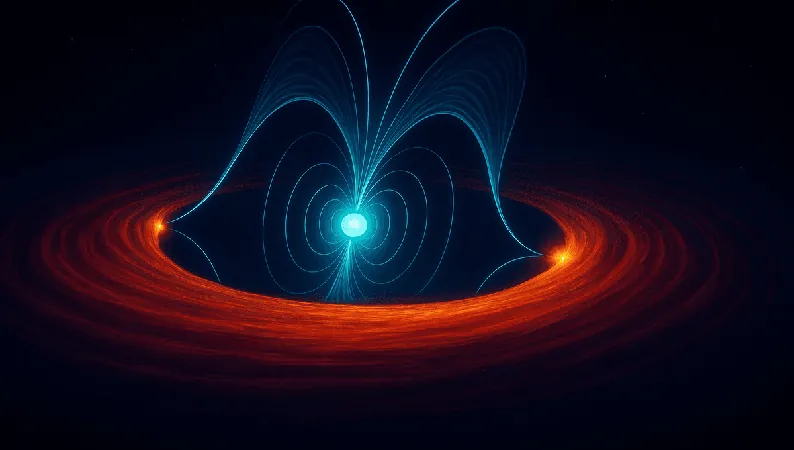
The Cosmic Thief: A Pulsar Spinning at 592 Times a Second Uncovers X-Ray Mysteries
2025-07-18
Author: Wei
Unlocking the Secrets of Pulsars
Pulsars, the enigmatic remnants of massive stars that have exploded as supernovae, are gaining new attention from scientists. These compact neutron stars don't just spin; they emit intense beams of electromagnetic radiation, pulsating rhythmically. One such pulsar, known as J1023, is particularly fascinating as it spins an astonishing 592 times per second—equating to a pulsation every 35,520 times a minute! But there's a twist: this pulsar has a unique ability to switch between an active state, where it actively siphons material, and a dormant state.
The Dance of Cosmic Theft
In its active phase, J1023 is a cosmic thief, drawing in material from a companion star that is about a quarter the mass of our Sun. This smaller star orbits the pulsar every 4.75 hours, and during this time, the pulsar displays vigorous radio pulsations and X-ray emissions.
Transitional Millisecond Pulsars: Cosmic Laboratories
According to Cristina Baglio from the Italian National Institute of Astrophysics, transitional millisecond pulsars like J1023 serve as vital cosmic laboratories. They help astronomers decipher the intricate evolution of neutron stars within binary systems, she shared. Thanks to an array of advanced observatories, including NASA's IXPE and several others, researchers have made groundbreaking discoveries about the origins of these X-rays.
X-Rays: The Mystery Unveiled
Initially, scientists believed the X-rays emitted from pulsars stemmed from an accretion disk formed by the material the pulsar steals from its companion star. However, fresh data dispelled this notion. Using innovative polarization techniques and observations from NASA's SWIFT and NICER telescopes, it was revealed that the X-ray emissions originate from the pulsar wind—a powerful outflow of high-energy particles enmeshed in robust magnetic fields.
A Unified Physical Mechanism
The alignment of polarization angles provided compelling evidence for a single physical mechanism governing the light observed. Co-lead author Francesco Coti Zelati remarked on the significance of these findings, stating, That finding is compelling evidence that a single, coherent physical mechanism underpins the light we observe. This research suggests the energy output in systems like J1023 is predominantly driven by the pulsar wind.
Conclusion: A New Era of Cosmic Insight
Philip Kaaret, an astrophysicist at NASA's Marshall Space Flight Center, expressed excitement about these revelations. IXPE has observed many isolated pulsars and found that the pulsar wind powers the X-rays. These new observations show that the pulsar wind powers most of the energy output of the system, he noted. As astronomers continue to peel back the layers of these celestial puzzles, the universe reveals its mysteries, one pulsar at a time.



 Brasil (PT)
Brasil (PT)
 Canada (EN)
Canada (EN)
 Chile (ES)
Chile (ES)
 Česko (CS)
Česko (CS)
 대한민국 (KO)
대한민국 (KO)
 España (ES)
España (ES)
 France (FR)
France (FR)
 Hong Kong (EN)
Hong Kong (EN)
 Italia (IT)
Italia (IT)
 日本 (JA)
日本 (JA)
 Magyarország (HU)
Magyarország (HU)
 Norge (NO)
Norge (NO)
 Polska (PL)
Polska (PL)
 Schweiz (DE)
Schweiz (DE)
 Singapore (EN)
Singapore (EN)
 Sverige (SV)
Sverige (SV)
 Suomi (FI)
Suomi (FI)
 Türkiye (TR)
Türkiye (TR)
 الإمارات العربية المتحدة (AR)
الإمارات العربية المتحدة (AR)